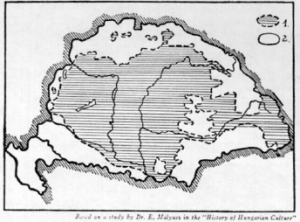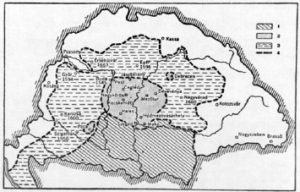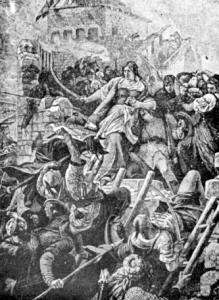Section I: History of Hungary
The Turkish Era
King Matthias died without heir. During the ensuing reign of the Jagello Kings, the political, economic and social climate in Hungary steadily deteriorated. Centralized power and leadership was non-existent and the following decades were characterized by internal disunity and strife. The Black Army was disbanded and Hungary’s border fortresses fell into disrepair.
The foreign kings were blamed for the many ills of the nation. Consequently, the Tripartitum law code was written, which clearly defined the role of the king, nobility and the peasant class. This code of law determined that the symbolic source of all power in Hungary was the Holy Crown. The code limited the powers of the king, and determined that all noblemen were equal. The Tripartitum also contained harsh enactments which were imposed on the peasantry in reprisal for the Peasant Uprising of 1514, which took place unexpectedly.
Cardinal Thomas Bakocz was entrusted with leading a crusade against the Turks. Thousands of peasants and soldiers gathered to take part; however, the outcome of the poorly organized and supplied expedition was disastrous. Led by György Dózsa, a professional soldier, the downtrodden peasants turned against their landlords and nobles instead. Atrocities took place on both sides. After the uprising was quelled, the unfortunate peasant class lost everything, including the right of migration. They were assigned to the status of wage earners exclusively, and allowed no ownership whatever. These enactments, set forth in the Tripartitum, caused an even greater rift between the nobility and the peasant class.
The inner turmoil of the country was compounded by the increasing threat of invasion by the Turks, who under the leadership of Suleiman Sultan began their advance toward Hungary in 1520. King Louis II pleaded in vain for assistance from the west. As confrontation became imminent, he gathered the army and met the Turks near Mohács in 1526. The Hungarians, outnumbered by about four to one, perished. The army of 25,000 was decimated with the death of the king, high clergy and many noblemen. The Turks gained access to the central plains of Hungary; this area suffered Turkish occupation for 150 years.
Western European nation states mourned Hungary’s defeat at Mohács, realizing only too late that all of Europe was suddenly exposed to attack. Humanists such as Thomas More and Erasmus openly expressed their concern for the future of Europe and disapproval of western nations for standing idly by as Hungary perished.
Hungary was subsequently divided into three sections: the central plains area ruled by the Turks, the western fringes dominated by the Hapsburg or Austrian kings and the eastern portion of the country, Transylvania, which became an independent principality. Hungary was never fully vanquished by the Turks, and even in the areas claimed by the oppressors, guerrilla warfare and resistance was widespread.
The Magyar fortresses were the outposts of fierce national resistance; remarkable accounts of the heroism displayed by the defenders were recorded. During the siege of Szigetvár, Nicholas Zrinyi led a suicidal charge from the fortress into the Turkish camp, during which the Suleiman Sultan himself was killed. After years of fighting, the forces and ammunition at Szigetvár were reduced to such a minimal level that only two choices remained: surrender or suicide.


Women fought side-by-side with the men in the fortresses. In several instances they are credited with changing the outcome of the battle in favor of the Hungarians. During the siege of Eger in northern Hungary when all the ammunition had been exhausted, the women of the fortress won the battle by pouring boiling water, burning oil and tar on the Turks. The superstitious Ottomans believed witches had come to the rescue of the Hungarians and retreated.
The Magyars, referred to by the Turks as “disobedient and stiff-necked dogs,” suffered enormous losses of population due to the wars, slave raiding and endemic pestilence. Hungary’s population of over 5,000,000 was drastically reduced to 3,000,000 by the end of the Turkish occupation. Historians postulate that had the Magyars capitulated, Hungary’s population, equal to that of many other western European nations during the fifteenth century, would have probably been spared decimation. The future development and history of Hungary were in large part determined by the ravages endured during this tragic era.
The eastern section of Hungary, Transylvania, was proclaimed an independent principality during the Turkish occupation of central Hungary. Until then, since the earliest Árpád kings, Transylvania was an integral part of Hungary. While Hungary’s cultural and social development was stifled by the occupying forces, the Hungarian princes of Transylvania established and maintained a powerful independent state where culture and the arts flourished, education was promoted and religion freely exercised. In fact, during the sixteenth and seventeenth centuries, at the time when religious wars were raging throughout Europe, Transylvania was a utopia of sorts. In 1557 the Diet of Torda officially proclaimed full religious freedoms.

István Báthory was the first of the powerful Transylvanian princes; he became King of Poland in 1576. István Bocskay, renowned defender of religious freedoms, was elected King of Hungary. Bocskay’s statue is part of the Reformation Monument in Geneva, his words “freedom is more precious than gold,” have been immortalized.
Gábor Bethlen (1613-1629) transformed Transylvania into an advanced European country. He contributed greatly to its’ cultural development by stimulating student exchange and facilitating excellent educational programs. Bethlen strengthened the economy by nationalizing many areas of foreign trade and enhancing mining and industry. As Prince of Transylvania and Hungary, his palace and court were at Gyulafehérvár, which became a famous center for the arts. Bethlen maintained a standing army, with which he protected the rights of Protestants throughout Europe from the excesses of the Counter-Reformation. The benefits of his reign were felt by all social classes, including the serfs. For instance, in Transylvania landlords were obliged to provide an education for the children of those serfs who wished to have their offspring educated.
Vlachs (Rumanians), attracted by the advanced social and economic conditions, migrated in significant numbers into Transylvania from the eastern provinces of Wallachia and Moldavia. They enjoyed social and religious freedoms under the Hungarian princes, who stimulated the growth of Vlach culture and education. The beginning of Rumanian literature was marked by the publishing of four gospels of the New Testament at Brassó (Brasov) in 1561. The first Rumanian Bible, translated from a Magyar version, also dates from this period. In the seventeenth century Prince Michael Apafy instituted Rumanian schools in Transylvania.
The seventeenth century was characterized by Hungarian wars against two enemies: the Turks, who were finally routed from the country in the 1690s, and the Austrians, or Hapsburg Kings, who abused their royal authority over the Hungarians and attempted on several occasions to abolish Hungary’s national rights and freedoms.
Nicholas Zrinyi, poet and soldier, whose great-grandfather was the famous defender of Szigetvár, presented the first major threat to the Turks and Austrians as leader of a unified Hungarian opposition. The time was ripe to liberate Hungary from the cruel yoke of the Turks and yet the Austrian Emperor-King of Hungary, Leopold, failed to take action. Zrinyi died before his dreams could be realized.
A daring conspiracy with the French, engineered by three Hungarian noblemen, was the next attempt at liberation. This unsuccessful plot, known as the Wesselényi Conspiracy, incurred the wrath of the Emperor and his henchmen who used it as an excuse to institute oppressive measures. In 1673 the Hungarian Constitution was suspended and absolutist rule imposed. As part of the reprisals, three hundred noblemen lost their estates. Widespread persecution of Protestants ensued, directed by the Austrian Roman Catholic hierarchy.
The misery of the Hungarian people grew more acute. Imre Thököly, a nobleman from northern Hungary, led the opposition in a revolt against the Hapsburgs. Refugees of the persecutions, impoverished noblemen and disbanded soldiers rallied around Thököly. This ragged army, although poorly equipped and trained, continually harassed the Emperor’s forces and won several decisive victories. In 1681 the Constitution was restored and the Emperor reconvened the Diet or governing body of the Magyar people.
1683 signalled the beginning of a sixteen year war of liberation from the Turks. The Ottomans laid siege to Vienna and were decisively beaten back. This victory gave the impetus all Europe had been waiting for. Buda was recaptured in 1686. All of territorial Hungary was recovered in the 1690s. Liberation was gained, however, at a tremendous cost in human lives and suffering. The country lay in ruins, the population was decimated. Royal power was not vested in a national king, but with the Hapsburgs. Moreover, Emperor Leopold, instead of initiating a desperately needed campaign of reconstruction, placed further penalties upon the already overburdened population.
Foreign mercenaries manned the outposts of Hungary. In some areas the imperial generals imposed reigns of terror, ordering imprisonment and/or executions at will. Fierce measures against Protestants were enforced. The estates previously confiscated from Hungarian noblemen were re-assessed; large indemnities were demanded by the Crown from their former owners. If they were unable to pay, the estates were sold to foreign buyers.
The subjugated Hungarians again revolted against their “liberators;” this time the leader of the open rebellion was Ferenc Rákóczi II, descendant of one of the most famous noble families in Hungary. Ferenc Rákóczi was taken from his family at an early age. He was raised and educated in Bohemia. The Emperor, assured that the young nobleman was thoroughly germanized, allowed Ferenc to return to his family estate in Transylvania. Once in Hungary, Rákóczi was so moved by the misery of his people that he took to arms. The struggle, known as the “Kuruc” uprising, lasted seven years (1703-1711). The uprising was characterized by the disappearance of all class as well as nationality distinctions; peasants and noblemen joined the revolt, Ruthenes and Slovaks fought side by side with the Magyars.
The Kuruc uprising ended with the Treaty of Szatmár, which was signed by the new Emperor, Charles, who looked with more favor upon his Hungarian subjects than his predecessors. Amnesty was granted to all who participated in the revolt. Charles swore to respect Hungarian national rights and to rule in accordance with Hungary’s own laws. Ferenc Rákóczi went into exile, first to France and later to Turkey, where he died in 1735. Some of the members of his entourage emigrated with him to France, where they became the founders of the French light cavalry. The most famous of these emigres was László Bercsényi, Marshall of the Hussars.
